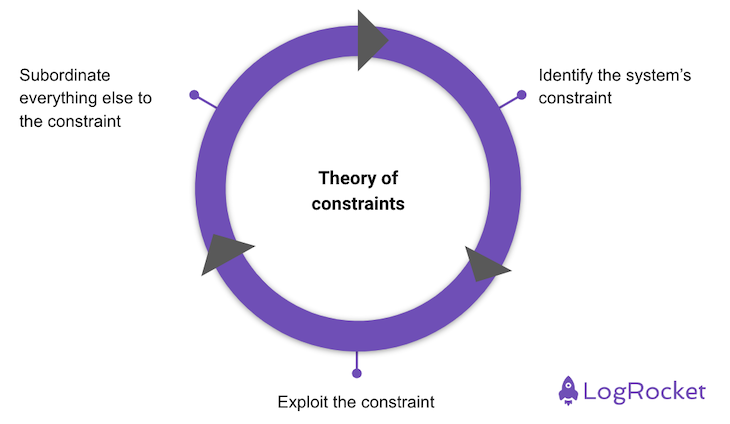
Continuous learning is a cornerstone of product management. Among the many principles and theories we study, the theory of constraints (TOC) is less common, but its classical yet straightforward approach brings insights that couldn’t be more contemporary.
Conceived by Dr. Eliyahu M. Goldratt, this theory has traditionally been employed in operations management, with a particular emphasis on manufacturing. As the nature of business evolves and you pivot towards a more service oriented economy, the TOC has demonstrated its applicability well beyond its initial scope.
The TOC works not only as a means to improve products, but also to deepen its applicability on B2B and SaaS discovery. This unique perspective empowers you to uncover insights that influence your product development strategies and fortify customer relationships.
In this article, you will learn what the theory of constraints is, how it can be applied to product management, and how to navigate an unconventional approach to it through strategies and practical examples.
The theory of constraints is a management theory that recognizes that each system has at least one constraint that prevents it from achieving its desired performance towards its long-term goal.
Recognizing and managing those constraints can greatly enhance the system’s effectiveness, whether it’s a production line, a supply chain, or even a service organization. Once the constraints are identified, improvement efforts should focus on mitigating the impact of the constraints on the system to maximize the potential for success.
Within the theory of constraints, there are three core actions:

Every process or system has a weak link, or a point where its efficiency is most restricted. Think of a piece of machinery in a manufacturing process that isn’t fast enough, or a particular step in a service provision that’s more time-consuming.
Identifying this bottleneck is the first step in the application of the TOC.
Once you’ve identified the constraint, the next step is to exploit the limitation by trying to maximize its efficiency with the resources already in place. This might involve ensuring that the identified machinery is never idle or fine-tuning the service stage to minimize delays.
The exploitation step isn’t a simple fix-it process. Similar to design thinking, exploiting involves the application of divergent thinking to explore opportunities of improvement.
After exploiting the constraint, all other aspects of the process should be adjusted to support this change. This could mean altering the speed of the preceding and following machinery to match the one improved, or rearranging work schedules to accommodate changes made to the service provision.
Applying these components successfully leads to reduced lead times and increased profitability. These help businesses focus on the aspect that limits them the most and rearrange their processes to optimize efficiency around this constraint.
As powerful as this theory is in the operational context, its applications can spill over to all industries. The same principles that enable you to identify bottlenecks in an assembly line and devise strategies to overcome them can be applied to completely different arenas.
If this is your first time reading about the TOC, you might think it has some similarities to the lean cycle (measure/learn/build). You’re not wrong. The lean cycle came directly from the theory of constraints, but the lean cycle uses slightly different steps as we’ll examine below:
Originally, the build step would kickstart the lean cycle, but ever since Eric Ries opus magnum was released, the lean cycle diverted from the build first approach to measure first in the form of data gathering and continuous user discovery.
Measuring is a broader concept than just looking for flaws, but they are essentially the same in nature — observe a system to find opportunities and take advantage of them.
Exploiting both acknowledges the best solution and also applies change. Because of this, you could say that exploitation is the counterpart to the build step on the lean cycle. However, doing so omits half of the value that this part of the cycle proposes.
Effective exploitation depends on a solid understanding of the challenges at hand and also of the solution to be applied. There is a hefty dose of learning hidden behind this part of the cycle.
Although textbook definitions differ vastly, subordination and building both require commitment. When you commit yourself to exploit, you subordinate everything to the change. When you commit yourself to a lesson, you apply all your resources into building it.
Both steps represent a point of no return from the previous state of your observed object.
Despite their similarities, one was built on the shoulders of the other. The theory of constraints is way more focused on action and delivery, while the lean cycle prioritizes learning.
Nonetheless, they are bound together by their iterative nature. Because of this, consider applying them together:
Now that you saw how to adapt the theory of constraints to a more modern, product approach, what about applying it raw? Is there a way to leverage this classic framework to gain contemporary advantage?
B2B, SaaS, and platform products have always been a pain point for product managers.
With low usage volumes and biased users that pressure for features rather than outcomes, applying best practices in those contexts can be challenging. However, the theory of constraints asks you to make three commitments:
Engage with your customers and users. Initiate a dialogue and invest in understanding their experiences, their current solutions, and their pain points. These are the constraints your customers are dealing with.
Use open-ended questions, surveys, interviews, or observations to gather this data. The better you understand your customer’s and users’ constraints, the better positioned you’ll be to address them.
Once the constraints are identified, the next step is to exploit them. Design your value proposition around the identified pain points to make your offer pop from the competition: enhance features, improve usability, offer better customer service.
The key is to address the customers’ or users’ constraints in a way that current offerings can’t. Coming up with an opportunity tree is an excellent way to connect constraints with possible exploit opportunities.
In this phase, ensure all product development efforts align with addressing the selected constraints. This alignment should influence your product roadmap, KPIs, and stakeholder communication. All the resources of your team should support the goal of exploiting the identified opportunity.
This step will likely involve close collaboration with multiple teams — design, development, marketing, sales, and possibly others. Clear communication of the identified constraints and the strategy to address them will be crucial for effective collaboration.
This data light approach and highly customer-centric framework should enable you to retain the iterative nature of what product management should be, while guaranteeing that you are delivering value that your customers love.
The theory of constraints teaches us to see the customer’s pain points not just as obstacles, but as opportunities for value delivery. It can equip product managers with a buffed iteration cycle, or with a more structured approach to a customer-centric product development when traditional literature might be a little lackluster.
Either way, the TOC is a constant in our day-to-day work, even though we don’t notice it. Rather than ignoring it, utilize the steps provided in this article to maximize the effectiveness of your product.

LogRocket identifies friction points in the user experience so you can make informed decisions about product and design changes that must happen to hit your goals.
With LogRocket, you can understand the scope of the issues affecting your product and prioritize the changes that need to be made. LogRocket simplifies workflows by allowing Engineering, Product, UX, and Design teams to work from the same data as you, eliminating any confusion about what needs to be done.
Get your teams on the same page — try LogRocket today.

A practical framework for PMs to use AI in ideation without sacrificing judgment, strategy, or decision quality.

A practical five minute revenue estimation method to help product managers compare ideas, drop low impact features, and prioritize smarter.

A practical guide for PMs who want to stop being bottlenecks, delegate smarter, and lead teams effectively with a clear ownership framework.

Stop letting unreliable data block features. Treat data as inventory to track quality, ownership, and ship with confidence.